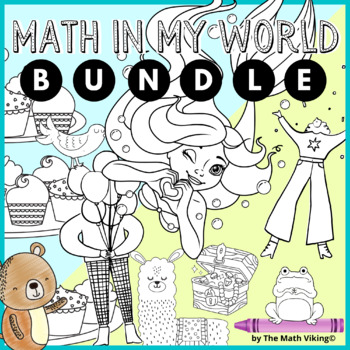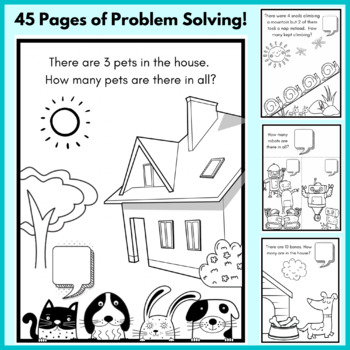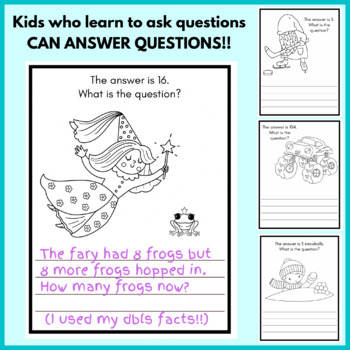Problem Solving 180 Coloring Tasks: Parts/Wholes, WODB, Story Starters Math Fun
- Zip
Products in this Bundle (5)
Bonus
Description
Math in My World: Best practice problem solving for 5-8 year olds! Introducing part whole models? Teaching comparison? Start the day with an appropriate coloring task BEFORE the lesson and see what happens! Want to build reasoning skills with an engaging soft start? Try a Which One Doesn't Belong math center.
180 Days of engaging coloring pages make great bell ringers, transition tasks and of course, math centers. These math coach created tasks allow less confident learners time to think and reason without stress and give the most confident learners something to work on.
(And of course they are a huge help to busy teachers who would love to start the day with something stress-free yet worthwhile.
INCLUDES:
- 50 Part Whole (addition & subtraction) Coloring Problem Solving Tasks
- 40 Math Story Starters Coloring Tasks- Here is the answer. What is the question?
- 35 Fun Coloring Pages comparison subtraction problems
- 55 W.O.D.B Coloring Pages!
WHY:
- Coloring has been proven to relax the mind.
- This is a great way to begin the day or the class with 100% independence.
- The coloring aspect allows less confident learners time to think without stress. Even if they cannot solve yet, they can color and reason.
- It also gives the most confident learners a natural extension - coloring.
- Age appropriate pictures support context, which is essential for problem solving.
- Pictures provide support for the text and when needed, the quantity.
- Pictures are representational. This is essential in the move from concrete to abstract thinking.
- Repeated experiences with comparison situations is vital in grades 1 and 2.
- Many little learners need MORE experiences with problem solving than busy teachers have time to provide- especially with comparison visuals!
- Engagement increases the desire to understand.
I initially created my Which One Doesn't Belong coloring pages to CALM DOWN the transition from lunch time to math time. I was thrilled with how well they worked and BLOWN AWAY by the level of reasoning and engagement. I went back to work and created the problem solving packs to continue the fun and thinking.
- What is the Question? Problem Solving Coloring Pages
- Parts & Wholes + - Problem Solving Coloring Pages
- How Many More? Problem Solving Coloring Pages
- Which One Doesn't Belong? Reasoning Fun Coloring Pages
I feel these work best all mixed up! (That's why the bundle is such a great deal.) After doing 5 days of part whole problem solving, try 5 days of WODB and then a week of "What is the question?" before you mix them all up as randomly as you like! All of the other problem solving packs can be introduced any time! Comparison subtraction should be introduced with the lesson, but revisited all year long.
Questions? Email at themathviking at gmail dot com
Thank you for exploring math with me!
Kristine @The Math Viking
Please check out my store for MATH COACH DESIGNED RESOURCES to foster deeper understanding. Follow me for notifications about awesome new products and sales!
For MORE PROBLEM SOLVING with actual thinking: Go Numberless!:
- My First Math Story Grades 1 & 2 (Math Libs and Writing your own word problems)
- Grade 1/Early 2 Numberless Word Problem Sort & Solve
- Grade 2 Standards Numberless Word Problems to Sort & Solve
Composing Numbers:
- The Hiding Game Center Activity
- Check out the MANY FREE Shake & Spills in my store!
- Addition and Subtraction Sorts: Composing Numbers 12 Sorting Activities
- PACKING COOKIES Place Value Unit
- Addition Fact Name Tags! K-2
Hundreds Chart Fun:
- 100 Number Dash! (The MOST FUN in MATH CLASS)
- First Grade Number of the Day Reasoning Templates!
- FREE Hundreds Chart Estimation Clipboard & Esti-Mysteries or DIY Mystery Number!
- FREE! DIY: Giant Write & Wipe Hundreds Chart for you Wall!
Flexible Place Value Fun:
- PACKING PRESENTS Flexible Place Value Unit
- PACKING PEEPS Flexible Place Value Unit
- Flexible Numbers Place Value Match Game & Scoot!
- MYSTERY NUMBER Place Value Freebie!
- MYSTERY NUMBER Scoot Task Cards for Place Value, Reasoning & Vocabulary
- Place Value Fugitives FREEBIE!
- A Place Value Chart Board Topper!
All rights reserved by The Math Viking© Copyright Information: Purchase of this unit entitles the purchaser the right to reproduce this pack for ONE classroom use only. If you plan on sharing with others, please purchase an additional license- or email me for special grade level or district wide pricing. Thank you!!





